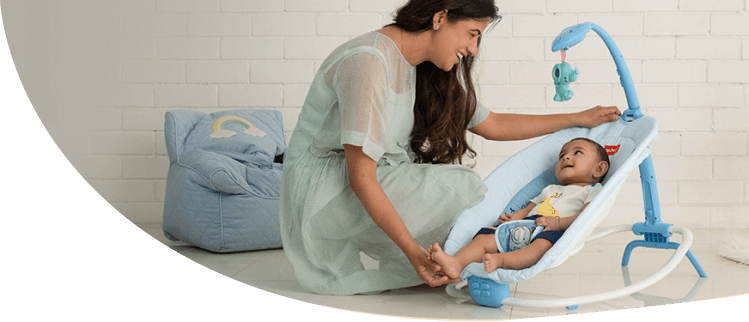

Categories
Baby Skin Care
-
Deal 0%Out Stock
Glory Hands-Free Electric Breast Pump for Breastfeeding, Wearable, Portable, 4 Modes & 9 Suction Levels, Type-C Fast Charging, 24mm Breast Shield, Includes 19/21/27mm Soft Flange Inserts, White
Regular price Rs. 4,476.00Sale price Rs. 4,476.00 Regular priceUnit price / perRs. 4,495.00You Save: Rs. 19.00 (1% off)
Sold out -
Deal 9%
Adore Electric Breast Pump
Regular price Rs. 3,629.00Sale price Rs. 3,629.00 Regular priceUnit price / perRs. 3,995.00You Save: Rs. 366.00 (10% off)
Sale -
Deal 5%
Adore Double Electric Breast Pump
Regular price Rs. 4,469.00Sale price Rs. 4,469.00 Regular priceUnit price / perRs. 4,695.00You Save: Rs. 226.00 (5% off)
Sale -
Deal 3%
Washable Breast Pads, 6 Pcs
Regular price Rs. 347.00Sale price Rs. 347.00 Regular priceUnit price / perRs. 359.00You Save: Rs. 12.00 (4% off)
Sale -
Deal 9%
Baby Breast Milk Storage Bags, BPA Free (Pack of 50 Bags)
Regular price Rs. 725.00Sale price Rs. 725.00 Regular priceUnit price / perRs. 799.00You Save: Rs. 74.00 (10% off)
Sale -
 SaleDeal 24%
SaleDeal 24%Manual Breast Pump
Regular price Rs. 604.00Sale price Rs. 604.00 Regular priceUnit price / perRs. 799.00You Save: Rs. 195.00 (25% off)
Sale -
Deal 9%
Baby Breast Milk Storage Bags, BPA Free (Pack of 25 Bags)
Regular price Rs. 409.00Sale price Rs. 409.00 Regular priceUnit price / perRs. 449.00You Save: Rs. 40.00 (9% off)
Sale -
Deal 14%
Ultra Thin Honeycomb Disposable Breast Pads, 36 pcs
Regular price Rs. 232.00Sale price Rs. 232.00 Regular priceUnit price / perRs. 269.00You Save: Rs. 37.00 (14% off)
Sale -
Out Stock
Natural Bamboo Washable Nursing Breast Pads, 8Pcs
Regular price Rs. 999.00Sale price Rs. 999.00 Regular priceUnit price / perRs. 999.00Sold out -
Deal 13%
Disposable Breast Pads, 48 Pcs
Regular price Rs. 304.00Sale price Rs. 304.00 Regular priceUnit price / perRs. 349.00You Save: Rs. 45.00 (13% off)
Sale -
Deal 60%
Natural Bamboo Washable Nursing Breast Pads with Lace, 10Pc
Regular price Rs. 483.00Sale price Rs. 483.00 Regular priceUnit price / perRs. 1,199.00You Save: Rs. 716.00 (60% off)
Sale -
Deal 60%
Natural Bamboo Washable Nursing Breast Pads with Lace, 6Pc
Regular price Rs. 320.00Sale price Rs. 320.00 Regular priceUnit price / perRs. 799.00You Save: Rs. 479.00 (60% off)
Sale -
Deal 60%
Bamboo Washable Breast Pads, 14 Pcs
Regular price Rs. 602.00Sale price Rs. 602.00 Regular priceUnit price / perRs. 1,499.00You Save: Rs. 897.00 (60% off)
Sale
Top 7 benefits of using breast pump:
A breast pump is a valuable tool that offers numerous benefits to breastfeeding mothers, enhancing convenience, flexibility, and overall feeding experience. Here are several key advantages:
Maintains Milk Supply: Breast pumps allow mothers to express milk when separated from their babies, ensuring a steady milk supply. This is particularly beneficial for working mothers or those who are temporarily away from their infants.
Supports Milk Production: Regular use of a breast pump stimulates milk production, especially in cases where direct breastfeeding may be challenging due to latch issues or medical reasons. It helps maintain adequate milk production and encourages milk flow.
Feeding Flexibility: Pumped breast milk provides flexibility in feeding schedules. It allows partners, family members, or caregivers to feed the baby, facilitating bonding opportunities for others while allowing the mother to rest or tend to other responsibilities.
Relief from Engorgement: Breast pumps can alleviate discomfort from engorgement, a common issue in breastfeeding mothers. By expressing milk, mothers can soften the breasts and reduce the risk of blocked ducts or mastitis.
Feeding Premature or Ill Babies: For premature infants or babies with medical conditions preventing direct breastfeeding, pumped milk is crucial. It provides essential nutrients and antibodies, aiding in their growth and recovery.
Sustained Breastfeeding: Pumping allows mothers to continue breastfeeding when they return to work or have other commitments. It supports extended breastfeeding goals by ensuring a consistent milk supply even when direct breastfeeding sessions are limited.
Increased Milk Storage: Breast pumps enable mothers to store milk for future use, creating a reserve for times when breastfeeding directly may not be feasible. This stored milk can be used during emergencies or when the mother needs to be away from the baby.
Important Do's and Don'ts Of Breast Pumping
Dos:
Cleanliness: Wash your hands before handling the breast pump equipment to minimize the risk of contamination.
Follow Instructions: Read and follow the instruction manual for assembling, using, and cleaning the breast pump by scanning QR code with the item package.
Proper Fit: Ensure that the breast shields (flanges) fit correctly. The nipple should move freely in the shield without rubbing.
Comfortable Settings: Start with a low suction setting and gradually increase to a comfortable level. Avoid high suction levels that cause pain or discomfort.
Massage and Warmth: Use gentle breast massage and apply warmth (e.g., warm compress) to stimulate milk flow before pumping.
Pumping Schedule: Establish a pumping schedule that mimics the baby's feeding patterns to maintain milk supply. Pumping sessions should typically be around every 2-3 hours.
Storage: Label and store expressed breast milk in clean containers or breast milk storage bags. Store milk in the refrigerator or freezer according to guidelines.
Hygiene: Clean pump parts thoroughly after each use. Disassemble all parts that come in contact with milk and wash them with hot, soapy water or use a dishwasher.
Don'ts:
Neglect Cleaning: Do not skip cleaning and sterilizing pump parts regularly. Proper hygiene is essential to prevent bacterial growth.
Incorrect Assembly: Avoid assembling the pump parts incorrectly, as this can affect its performance and may lead to discomfort.
Overuse: Do not overuse the breast pump. While pumping is necessary for some situations (e.g., returning to work), excessive pumping can lead to overstimulation and potential discomfort.
Storage Mistakes: Do not store breast milk in disposable bottle liners or regular plastic bags. Use breast milk storage bags or containers specifically designed for storing breast milk.
Mixing Temperatures: Do not mix freshly expressed milk with previously refrigerated or frozen milk. Cool freshly pumped milk before adding it to previously cooled milk.














